Bottling (called “canning” in the US)
The Fresh Girl’s Guide to Easy Canning and Preserving – Ana Micka – Voyageur Press (US) 2010 ISBN 978 0 7603 3846 9 – And no, before you ask I am NOT a fresh girl! A very helpful DVD comes with the book. Good for those starting out, I bought a copy for each of my daughters; it covers atmospheric and pressure canning.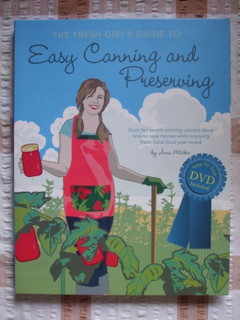
Out of the Bottle – Sally Wise – ABC Books (AUS) 2010 ISBN 978 0 7333 2557 1 – A follow up to “A Year in a Bottle” this book provides a series of processes for bottling various types of produce and then goes on to recipes for using your preserved foods. We can recommend the curry paste and tomato chilli chutney recipes.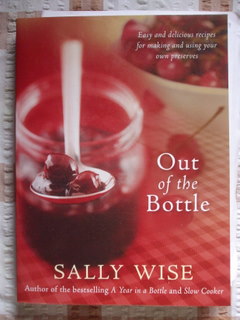
The Best-Ever Book of Preserves – Catherine Atkinson and Maggie Mayhew – Hermes House (UK) 2008 ISBN – 978 1 84661 308 5 – This is a massive book with over 140 recipes covering jams, jellies, pickles, relishes and chutneys and with over 220 photos. We picked it up at a remaindered book sale and have seen several very similar versions of the same book with different bindings. It was quite cheap and if bottling is your bag, worth the money.
The Complete Guide to Home Canning and Preserving – US Dept of Agriculture – Dover Books (US) 1999 ISBN 0 486 40931 7 – This the reprint of a series of USDA guides for home canning. No photos but a series of very clear line drawings that are better than photos. The guides cover the basic principles of home canning, the selection, preparation and canning of fruit, tomatoes, vegetables, poultry and red meat, fermented foods and picked vegetables and the canning of jams and jellies. Lots of detail and good information.
Perfect Preserves – Joan Wilson – Viking O’Neil (AUS) 1991 ISBN 0 670 90425 2 – This book contains over 300 recipes, including 7 recipes using chokoes! The book has no photos or drawings but lots of good information and recipes covering jams, conserves, jellies, marmalades, chutneys, relishes, vinegars, pickles, mustards and sauces. There is a good section on the basic process and even tips for microwave bottling.
The Book of Preserves – Pamela Clark (Ed.) – The Australian Women’s’ Weekly (AUS) 1990 ISBN 0 949892 70 X – This book has lots of good recipes and lots of colour pictures and covers relishes, jams and conserves, marmalades, jellies, chutneys, pickles, sauces, butters and spreads and liqueurs.
Jam It! – Gina Steer – Parragon Books (UK) 2009 ISBN 978 1 4075 7031 0 – A small book with lots of full page colour photos and only 1 recipe per page. The book covers jams and conserves, jellies, marmalades, curds and butters, chutneys pickles and relishes and preserves but only has a handful of recipes in each section.
Smoking
Home Smoking and Curing – Keith Erlandson – Vermillion (UK) 1993 ISBN 0 09 177825 5 – This small paperback has almost no photos but some good line drawings and lots of information. The book covers the basic smoking process , pre-salting, fuels, equipment (including making your own smoker) hot and cold smoking and storage of smoked foods.
Smokin’ – Brad Parkes – The Halcyon Press (NZ) 1999 ISBN 0 908685 64 5 – A good little book on smoking produced by our Kiwi cousins across the ditch. The book has some good details, mostly line drawings but some photos, on commercially available smokers as well as DIY types. Preparation and salting are covered as well as hot and cold smoking and lots of detail on smoking fish and other seafood, pig products, beef and chicken as well as local game. A good little book.
Dehydrating (Drying)
Drying Fruit, Vegetables & Herbs – Doug Kneen – Victorian Dept. Of Agriculture (AUS) 1991 ISBN 1 86337 051 X – No photos but a few line drawings, this small book includes equipment required and the process for drying fruit vegetables and herbs as well as storage of dried product and some recipes for using the dried product.
Drying Food – Ricky M Gribling – Hyland House Publishing (AUS) 1997 ISBN 1 875657 61 4 – The book has some appetising photos as well as line drawings of the dehydrators. The book covers dehydrating soups, grains, proteins (e.g. Bacon, beef, cheese, yoghurt etc), fruit, vegetables and herbs and after a discussion on how to dry them, recipes for how to use the dried product are provided. Some difficult to get and unusual information is provided in this book, it is well worthwhile if you can get it. There was also a similar book on smoking brought out at the same time by the same publisher, but I don’t have it.
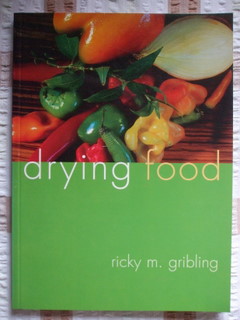
Mary Bell’s Complete Dehydrator Cookbook – Mary T. Bell (funny ‘bout that) – William Morrow and company Inc. (US) 1994 ISBN 0 688 13024 0 – This comprehensive book is broken up into two sections, the first one giving the details on how to dry fruit, vegetables, herbs, meat and fish and the second section giving a series of recipes showing how to use the different types of dehydrated foods. No photos or line drawings.
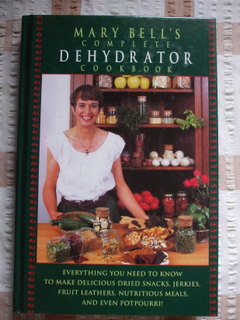
Making and Using Dried Foods – Phyllis Hobson – Storey Publishing (US) 1994 ISBN 978 0 88266 615 0 – Not a big book but lots of info. There is a good section at the start about what to look for when buying a dehydrator followed by discussion on the pros and cons of pre-treating then details on drying individual fruits, vegetables and herbs as well as meats, dairy products and grains. This is a good book worth having.
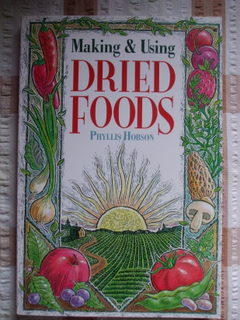
Dehydrating Food: A Beginner’s Guide – Jay and Shirley Bills – Skyhorse Publishing (US) 2010 ISBN 978 1 60239 945 7 – Flashy book with lots of colour photos but lacks the depth of information of other books. It also contains extensive quotes from an old and presumably out of print book on food drying. The book does contain 164 recipes for using dehydrated food products and cover dehydrating fruit, vegetables, meat and herbs.
Root Cellaring
This is not a big thing here in Australia and it is a rare house that has a cellar but there are several designs for small scale root cellars out there that may be worth adapting to our local conditions.
The Second Earth Garden Book – Keith and Irene Smith (Eds.) – Thomas Nelson (AUS) 1978 ISBN 0 17 005293 1 – This is the only local info that I am aware of by anyone who has built a root cellar in Aus and is covered on pages 205 to 207 if you can get hold of it.
Root Cellaring – Mike and Nancy Bubel – Storey Publishing (US) 1991 ISBN 978 0 88266 703 4 – The book has good B&W photos and line drawings. It starts off with growing and harvesting vegetables for root cellaring, then covers treating fruits and vegetables before storage. The book also has a large section on the DIY root cellar and some ideas are translatable to the urban and suburban environment. This is a good book and worth getting if root cellars are your bag.
The joy of Keeping a Root Cellar – Jennifer Megyesi – Skyhorse Publishing (US) 2010 ISBN 978 1 60239 975 4 – Regardless of the title, this book also covers drying, canning, picking and freezing for food storage, with preservation of meat, dairy and eggs also being covered. All told only about 20% of the book actually covers root cellaring. There are lots of colour photos which gives this book a “coffee table book” feel and reduces the amount of information presented although there is still some good info.
Meat Preserving
Many of the books listed above contain sections on meat preserving but due to its peculiar techniques and hazards there are a few books that deal with meat specifically.
The Complete Book of Butchering, Smoking, Curing and Sausage Making – Philip Hasheider – Voyageur Press (US) 2010 ISBN 978 0 7603 3782 0 – Previously I have been perhaps a bit dismissive of lots of colour photos but in a book of this type covering butchering and meat preservation you really need them and this book has them, lots of them! I will say it is a good book to steer clear of if you faint at the sight of blood. This is a great book that gives lots of detail about harvesting, breaking down and preserving your own meat and is a worthwhile addition to your library.
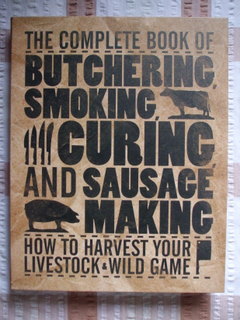
Butchering, Processing and Preservation of Meat - Frank G. Ashbrook – Van Nostrand Reinhold (US) 1955 (although my copy is a much more recent reprint) ISBN 0 442 20377 2 – OK no colour photos but lots of B&W and lots of good detail covering the butchering, breaking down and preserving of cattle, pigs, sheep, game, poultry and fish. A good book if you can get it!
Mastering the Craft of Making Sausage – Warren R. Anderson – Burford Books (US) 2010 ISBN 978 1 58080 155 3 – This book has it all! The equipment and supplies you need, hygiene and food safety, Grinding, mixing, stuffing and cooking sausages as well as smoking and curing them. There is also a whole stack of recipes for fresh, cured, emulsified and fermented style sausages. It is a thick book with lots of info, plus some B&W photos and good line drawings.
Home Butchery in Australia – Alec Mc Vicar – Gary Allen P/L (AUS) 1993 ISBN 1 875169 40 7 – The main thrust of this book is the butchery side and so is really aimed at our country cousins but there are some notes on meat processing and preservation towards the end. The freezing, drying, smoking and salting of meat is covered.
Pickling
Creative Pickling at home – Barbera Ciletti – Lark Books (US) 2000 ISBN 1 57990 307 X – The book starts off with a discussion of vinegar then provides a list of pickle recipes to make and finishes of with a series of recipes showing how to cook with pickled ingredients. This is a good book with lots of detail and a considerable number of colour photos and has a good discussion of the basics of pickling and the equipment required. If pickles are your thing, this is the book for you.
Quick Pickles – Chris Schlesinger, George Willoughby and Dan George – Chronicle Books (US) 2001 ISBN 0 8118 3015 2 – These are quick easy recipes but tend to only keep for a number of weeks and require refrigeration so it is more for the taste that these are made rather than long term preserving. The book covers fresh fruit and vegetable pickles, fermented pickles, oil pickles and pantry pickles, which tend to have a longer shelf life.



